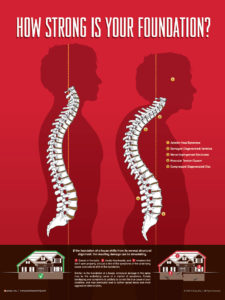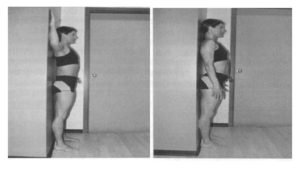Your shoulder is one of the most complex joints in your body. It is surrounded and supported by a complex network of nerves, tendons, muscles, and ligaments. Many of these structures tie back to your spine or mid-back and neck. Your posture, or position, directly impacts the motion of your shoulder and scapula. When the shoulder and scapula are moving properly, they work together. When they aren’t, the arm does more of the work leading to more stress on the rotator cuff leading to strains and possibly tears over time.
Long hours at a desk or computer can lead to postural changes and muscle imbalances. Poor posture and a forward head position can lead to “upper cross syndrome.”
Upper cross syndrome is an imbalance of the muscles in your upper back, neck, and shoulder that can lead to neck, back, and shoulder pain with restricted range of motion. The head translates forward shortening the muscles and tissues on the front side of the body and lengthening the muscles on the back.
Suppose you held a five pound weight out in front of your body for hours at a time. You’d undoubtedly feel tired and sore from trying to hold it up, right? Well, the reason why your shoulders and upper back are ‘barking’ at you is because your posture is losing and gravity is winning.
Simply trying the rehabilitate the shoulder only isn’t going to help since the problem is more global than regional.
Why it Matters:
Whether it’s working at a computer, long hours in a car, or using a tablet/smartphone, just about everyone is susceptible to developing upper cross syndrome. However, you don’t need to suffer or change your career to find relief.
A combination of Chiropractic adjustments, stretching, and specific postural exercises can make a huge impact on your ability to stay happy and healthy. Taking short breaks every 20-30 minutes to lightly extend your arms and move your neck through a comfortable range of motion will help your body “reset” while working. Also, periodic Chiropractic adjustments will help you maintain an optimal range of motion and reduce restrictions that can occur in your spinal joints.
Here are some simple exercises you can do RIGHT NOW to help yourself.
- Wall Slides –
- Place heels, buttocks, upper back, and head against wall
- Bend elbows to 90 degrees and rotate outwards so that the backs of your hands touch the wall (or as close as you can)
- Slide arms up the wall while keeping elbow bent at 90 degrees and keeping the elbows against the wall (or as close as you can)
- Tuck chin slightly to create flexion in upper neck.
- Relax and inhale, exhale slowly while pressing back of head and arms against wall.
- Progress slowly in terms of number of repetitions and force applied; Hold for 30 seconds.
- Pec Stretch:
- Stand in a doorway with arms bent to 90 degrees.
- Elbows and forearms are held against door frame.
- Step/lean through doorway to stretch.
- Inhale, then relax and exhale as you press a little further.
- Hold for 30 seconds
- T Exercises
- Stand or sit upright.
- Extend arms straight out in front of you and palms facing upwards.
- Pull arms out to the sides fully keeping arms parallel to the ground.
- Extend arms back behind you until.
- Squeeze shoulder blades together at the back.
- Hold for 5 seconds. Repeat 8-10 repetitions.
In review:
- The shoulder is one of the most complex joints in the human body.
- Your posture greatly impacts the ability of your shoulders to move through their full range of motion.
- It’s important to address the neck and mid-back when treating a shoulder injury.
Next Steps:
Upper cross syndrome is one of the most common complaints we see in our practice. Far too many people suffer from pain for years before discovering Chiropractic care. Millions of people end up taking medications just to get through the day. The trouble is, the medications don’t solve the problem.
So like you, we believe there is a better way. Share this information with a friend at work. We are excited to share how the challenges of upper cross syndrome can be overcome without drugs or surgery!
Science Source:
Upper Crossed Syndrome and Its Relationship to Cervicogenic Headache. JMPT 2004 MedicalNewsToday.com






